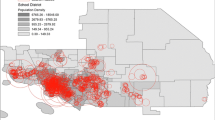Abstract
Methods for determining the optimum location site for the educational plant have traditionally classified the school as unifunctional in its production activities. Rising pressures of competition for land in urban areas suggest the need for novel approaches to planning public land use for fostering higher levels of living desirability of the urban environment. National concern about the less than optimum use of social investments in educational plants can be juxtaposed to the urban land use problem.
Empirical investigations in both economic and noneconomic disciplines are drawn upon to provide a broader concept of the urban school location problem. The multifunctional production potential of the school facility can raise the expected rate of social and economic returns on a necessary social investment. Thus, the school site decision is integrated with the more general problem of urban planning.
Similar content being viewed by others
Bibliography
Jeanne Dost. Determination of the Location for an Area School. Paper presented at the Western Regional Science Association Meeting, Las Vegas, January 27–29, 1967.
Walter Isard.Methods of Regional Analysis: An Introduction to Regional Science, pp. 528–533. New York, John Wiley, 1960.
Hector Correa. “Optima for the Size and Number of Schools,”Scientia Paedagogica Experimentalis, III, pp. 1, 5–15.
Melvin M. Webber. “Culture, Territoriality, and the Elastic Mile,”Regional Science Association Papers, 13, 1964, pp. 59–69.
Ellen Lurie. “Community Action in East Harlem,” in Leonard J. Duhl, Ed.,The Urban Condition: People and Policy in the Metropolis, pp. 246–258. New York: Basic Books, 1963.
MelvinM. Webber. “Order in Diversity: Community Without Propinquity,” in Lowdon Wingo, Jr., Ed.,Cities and Space, the Future Use of Urban Land, pp. 23–54.
Herbert J. Gans.The Urban Villagers, Group and Class in the Life of Italian-Americans. New York, The Free Press of Glencoe, 1962.
Michael Young and Peter Willmott.Family and Kinship in East London. London, Routledge and Kegan Paul, 1957.
Peter Willmott and Michael Young.Family and Class in a London Suburb, London, Routledge and Kegan Paul, 1960.
Jane Jacobs.Death and Life of Great American Cities. New York, Random House, 1961.
Wilbur R. Thompson.A Preface to Urban Economics, p. 138. Baltimore, Johns Hopkins Press, 1965.
Bert E. Swanson. “The Concern for Community in the Metropolis,”Urban Affairs Quarterly, June 1966, pp. 33–44.
Joseph Featherstone. “Education: Notes on Community Schools,”The New Republic, December 9, 1967, pp. 16–17.
Mark Perlman. “The Economics of Human Resources in the American Urban Setting: Some Concepts and Problems,” in Mark Perlman, Ed.,Human Resources in the Urban Economy, pp. 1–20. Washington, D. C., Resources for the Future, 1963.
Leonard J. Duhl. “The Human Measure: Man and Family in Megalopolis,” in Lowdon Wingo, Jr., Ed.,Cities and Space, the Future Use of Urban Land, pp. 133–152. Baltimore, Johns Hopkins Press, 1963.
Jonathan Kozol. “Where Ghetto Schools Fail,”The Atlantic. October 1967, pp. 107–110.
Gary S. Becker.Human Capital: A Theoretical and Empirical Analysis, with Special Reference to Education. New York, National Bureau of Economic Research, 1964.
John M. Richards. “The Significance of Residential Preferences in Urban Areas,” in Mark Perlman, Ed.,Human Resources in the Urban Economy, pp. 123–136.
J. R. Meyer, J. F. Kain, M. Wohl.The Urban Transportation Problem. pp. 146–163. Cambridge, Harvard University Press, 1965.
Cf. Arthur Maass. “Benefit-Cost Analysis: Its Relevance to Public Investment Decisions,”Quarterly Journal of Economics. May 1966, pp. 208–226.
Research and Policy Committee.Raising Low Incomes Through Improved Education. New York, Committee for Economic Development, September, 1965.
Additional information
iThe author is Assistant Professor, Department of Economics, Oregon State University.
Rights and permissions
About this article
Cite this article
Dost, J. Reassessment of the school location problem: A multifunctional role for the school in the urban environment. Ann Reg Sci 2, 136–141 (1968). https://doi.org/10.1007/BF02096183
Issue Date:
DOI: https://doi.org/10.1007/BF02096183




